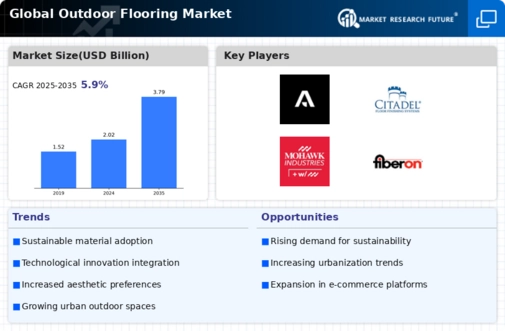Market Trends
Key Emerging Trends in the Outdoor Flooring Market
The outdoor flooring market is experiencing notable trends driven by various factors influencing consumer preferences and industry dynamics. One significant trend is the growing popularity of outdoor living spaces and the increasing focus on outdoor aesthetics and functionality. With a rising emphasis on outdoor leisure and entertainment, homeowners are investing in outdoor flooring solutions that enhance the visual appeal and usability of their outdoor spaces. As a result, there's a surge in the demand for outdoor flooring materials such as wood decking, composite decking, porcelain tiles, natural stone, and concrete pavers, which offer durability, versatility, and aesthetic appeal for patios, decks, terraces, and other outdoor areas.
The main restraining force which hinders the growth of the Outdoor Flooring Market is the rise in the demand because of the increase in construction in developing countries like China, India, the US etc. Due to the demand because of the increase in construction development, the key players are struggling hard to produce the product which is needed in a short time. Also because of the pandemic, production was slow because of the lack of raw materials, shortage of labour and also due to the lack of financial support. All these are because of the pandemic spread, so there was a fluctuation in the cost of the products. So the key players are facing some negative impacts due to some of the restraining factors. Also, the increase in the demand for the usage of the Outdoor Flooring Market products has created an urge to produce the products.
Another prominent trend in the outdoor flooring market is the shift towards sustainable and eco-friendly materials. With growing awareness about environmental sustainability and the need to reduce carbon footprint, consumers are seeking outdoor flooring options that are made from recycled materials, renewable resources, or environmentally friendly manufacturing processes. Sustainable outdoor flooring materials such as recycled composite decking, reclaimed wood, bamboo, and eco-friendly porcelain tiles are gaining traction as eco-conscious consumers prioritize environmentally responsible choices for their outdoor living spaces.
Furthermore, the COVID-19 pandemic has influenced certain trends in the outdoor flooring market, particularly in terms of outdoor living and home improvement projects. With increased time spent at home and a growing focus on outdoor activities, homeowners are investing in outdoor flooring projects to create functional and inviting outdoor spaces for relaxation, recreation, and entertainment. This has led to a surge in demand for outdoor flooring materials and products as consumers seek to enhance their outdoor living experience and maximize the usability of their outdoor areas.
Moreover, technological advancements and innovation are driving product development and differentiation in the outdoor flooring market. Manufacturers are investing in research and development to introduce advanced outdoor flooring solutions with enhanced performance, durability, and aesthetic appeal. This includes the development of outdoor flooring materials with improved weather resistance, UV stability, slip resistance, and low maintenance requirements, catering to the diverse needs and preferences of consumers for outdoor flooring solutions.
Additionally, design trends and preferences are shaping the outdoor flooring market landscape. Consumers are increasingly drawn to outdoor flooring designs that mimic the look and feel of natural materials such as wood, stone, and concrete, while offering the durability and performance benefits of modern materials. This has led to a growing demand for outdoor flooring products with realistic wood grain textures, natural stone finishes, and authentic colors that complement outdoor aesthetics and blend seamlessly with surrounding landscapes.
Furthermore, regulatory standards and building codes influence the outdoor flooring market, particularly in terms of safety and compliance requirements. Governments and regulatory bodies enforce standards and regulations related to slip resistance, fire safety, and structural integrity for outdoor flooring materials and installations to ensure public safety and building code compliance. Manufacturers and suppliers must ensure that outdoor flooring products meet or exceed regulatory requirements and industry standards to maintain market competitiveness and ensure customer satisfaction.








Leave a Comment